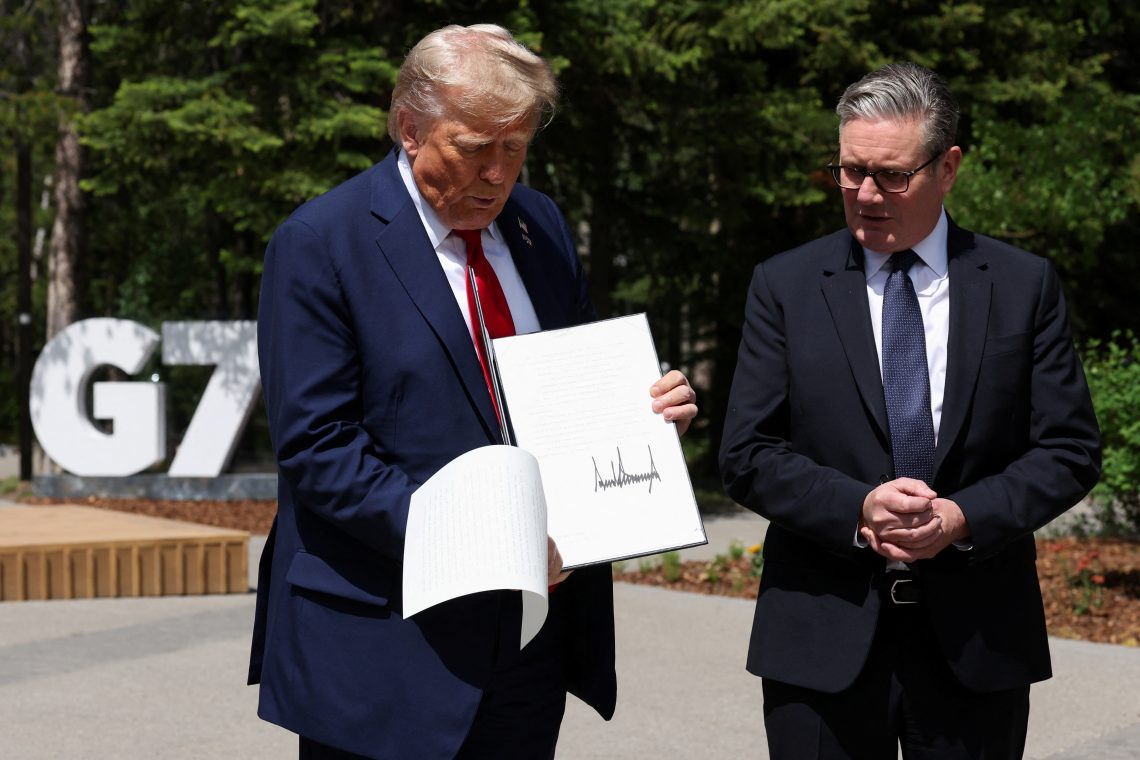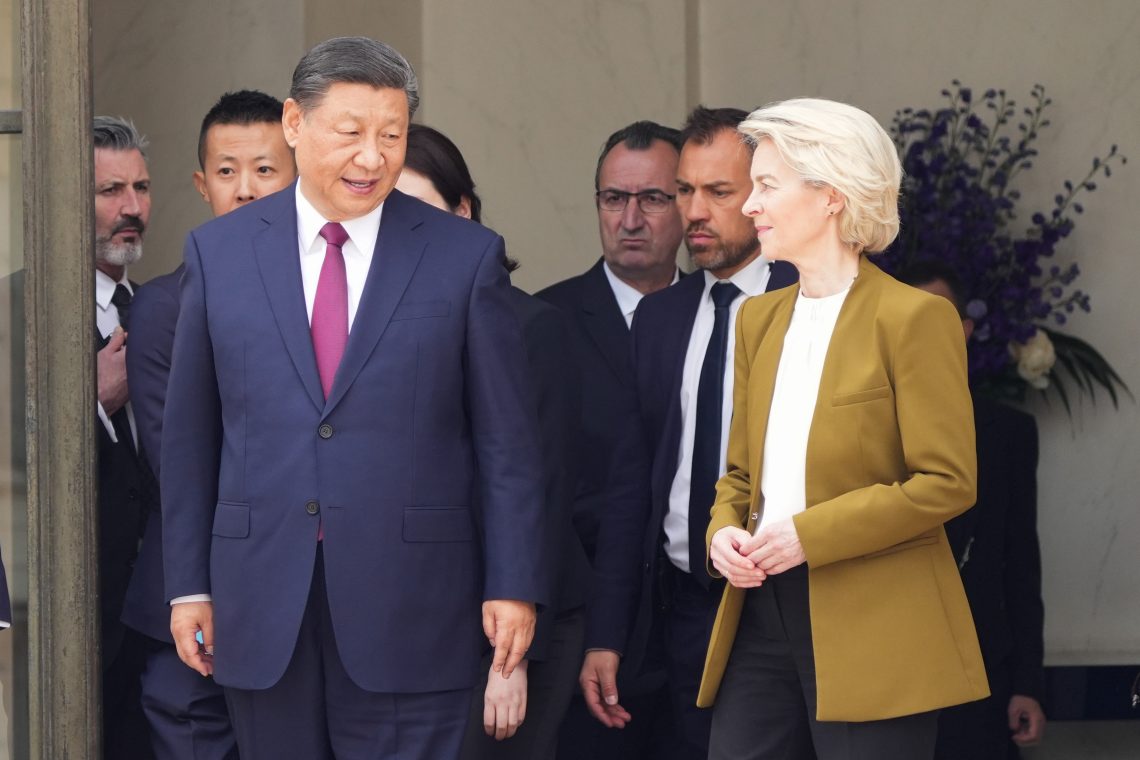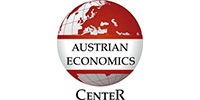UK aligns with U.S.
in security-driven global trade shift
The American-British trade relationship, once framed primarily by economic liberalism, is emerging into a nexus of investment, trade and technology security amid strategic alignments in the face of rising global tensions.
For the United Kingdom, whose economy is still adjusting to the post-Brexit and post-pandemic environment, the goals of the United States-UK Economic Prosperity Deal (EPD) complicate that adjustment phase by transcending traditional tariff and quota concerns to encompass geopolitical issues.
For Washington, this deal highlights its preference for bilateral agreements, with the U.S. wielding most of the bargaining power. This includes imposing its objectives of marginalizing global rivals, particularly China, from other world economies. The strategic innovation is clear; rather than relying on a singular, comprehensive trade deal akin to the Trans-Pacific Partnership (TPP) − which the first Trump administration had rejected − the U.S. appears to be experimenting with smaller, modular agreements focused on specific strategic goals.
The EPD could serve as the model for a broader economic security architecture involving countries willing to maintain strong political, economic and defense relations with the U.S., at the expense of others.
The UK bends to U.S. interests: Economic security over free trade
The terms of the EPD’s security arrangements, broadly referred to as “shared national security priorities” and “security of the supply chains,” are undefined and subject to ongoing detailed talks. Their invocation in the deal suggests an orientation toward trade policy being determined largely by defense and security concerns.
As a result, the EPD incorporates bilateral economic interests and a broader alignment of geopolitical strategies, albeit more in line with U.S. geostrategic interests, such as securing international supply chains, controlling critical technologies and reducing dependencies on competitors. This is particularly evident in the agreement’s national security provisions, which require strengthening “cooperation on economic security,” despite Washington not yet employing a specifically defined economic security strategy.
Even so, the terms point toward an intention to coordinate efforts “to address non-market policies of third countries.” One can plausibly assume that the wording of this provision is principally aimed at Beijing, which is often charged by U.S. administrations for engaging in non-market economic policies.
Washington’s essentially self-serving stance and London’s acceptance of these measures highlight the sharp reversal of UK trade policy.
London appears to have surrendered the sovereignty it had supposedly gained after Brexit, by towing the line with Washington’s national interests.
After its departure from the European Union in January 2020, the UK prioritized forging independent relations with countries around the world as part of a “Global Britain” policy. Now, London appears to have surrendered the sovereignty it had supposedly gained after Brexit, by towing the line with Washington’s national interests.
In particular, the EPD’s provisions on economic security stand in contrast to UK Prime Minister Sir Keir Starmer’s reset in UK-China relations shortly after his election in 2024. At that time, his diplomacy with Beijing represented a strategic shift towards engagement and cooperation – a departure from previous UK governments’ frosty relations with Beijing. Prime Minister Starmer looked to attract Chinese inward investment and imports of consumer goods in return for exports of UK financial services to China’s economy.
Furthermore, the EPD requires that in securing access to their respective government procurement markets, the UK should apply new national security powers. These measures would ensure that non-treaty nations, such as China, do not automatically receive non-discriminatory treatment when bidding for government projects in the UK.
Such a measure, if implemented, may not be supportive of China in its current negotiations toward becoming a full member of the World Trade Organization’s (WTO) Government Procurement Agreement program.
Limited upside of the U.S.-UK deal
Although the UK has conceded much of its sovereignty in favor of aligning with U.S. geopolitical interests, London has arguably not gained much in terms of trade benefits from the deal. In fact, the EPD’s conditions may well leave the UK worse off than it was prior to President Trump’s “Liberation Day” tariffs on April 2, with few tangible benefits in sight.
One of the key issues is that the EPD’s trade provisions run counter to the principles of the WTO. This may be primarily attributed to the preservation of Mr. Trump’s 10 percent across-the-board tariff. The U.S.’s offer of a new 10 percent baseline and its acceptance by the UK may indicate that this is becoming America’s new de facto Most Favored Nation (MFN) rate.
This may have important implications since over 80 percent of global trade occurs under MFN conditions. Any acceptance of unilateral provisions, such as those under the EPD, could lay the groundwork for other U.S. trade deals to follow suit.
The various tariff concessions which the UK received under the EPD, including removal of 25 percent levies on British steel and aluminum exports to the U.S., which originally applied on Liberation Day, are, however, not legally binding.
Furthermore, while a quota on steel and aluminum will be negotiated, no specific figures were mentioned. The UK would also be required to meet a tracking standard to measure the content of those products, which is unspecified.
The agreement also leaves room to negotiate down duties on U.S. section 232 trade investigations that have not yet concluded, which includes pharmaceuticals. This means an onerous and uncertain outcome for the UK, as it will need to negotiate a new deal on each and every one of the section 232 investigations opened by the White House.
Although the UK received a reprieve on vehicle tariffs, it is worse off than where it started in 2025. Under the EPD’s new quota system, the first 100,000 UK-made vehicles imported into the U.S. would fall under the baseline 10 percent tariff, and any excess would be subject to a 25 percent levy. Since this amount is roughly equivalent to UK annual vehicle exports, the imposition of the higher rate may still result in an export decline.
Aside from the negative implications for the UK, the EPD does not augur well for other countries in their efforts to conclude favorable trade deals with the U.S. in the future.
Is the UK shifting away from traditional trade agreements?
The new U.S.-UK deal symbolizes a move away from traditional free trade agreements (FTAs) in favor of strategic partnerships that emphasize non-trade agendas, including economic security concerns.
In this light, the UK is engaging in realpolitik. As a middle-power no longer participating in a major regional economic bloc, London has little choice but to employ a double-edged trade strategy; one involving greater security alignment with the U.S., and another seeking improved trade with other major economies.
This includes the UK agreeing to an FTA with India only days prior to concluding the EPD. To this end, the UK-India FTA is a more traditional trade and economic arrangement, and certainly more connected with a post-Brexit independent trade policy.
Around the same time, the UK also reached agreements on several key issues with the EU, commonly referred to as a “Brexit reset,” which may be something of a middle ground. The negotiations with Brussels not only involved greater harmonization and cooperation over specific mutual economic and political interests, but also established a new Security and Defense Partnership. While this arrangement involves an element of sovereignty pooling with the EU, it potentially gives the UK access to the bloc’s upcoming large-scale defense procurement programs.
Export controls and strategic technologies
The EPD includes provisions – or at least political intent – toward harmonizing export controls on sensitive technologies like semiconductors, artificial intelligence, quantum computing and biotechnology.
The UK has already aligned its export controls regime with the U.S. International Traffic in Arms Regulations and Export Administration Regulations in several critical areas. Deeper harmonization through the EPD would cement this cooperation and simplify compliance for transatlantic firms.
The trade deal could thereby serve to institutionalize closer cooperation on export controls, ensuring that neither country’s companies inadvertently supply critical technologies to geopolitical rivals. This U.S.-UK alignment could lead to a broader network of export control regimes among like-minded countries, such as the G7 and the Quad nations.
Moreover, the agreement could include provisions to prevent Chinese firms from using the UK as a backdoor to circumvent U.S. sanctions. Since China’s Huawei was initially permitted to develop the UK’s 5G networks before being banned under U.S. pressure, the agreement’s subsequent negotiations might formalize stricter coordination on such decisions, reinforcing a unified U.S.-UK stance against perceived security threats from other Chinese technology companies.
Scenarios
Somewhat likely: The EPD shapes future trade deals, fragmenting global supply chains
The U.S.-UK deal, and others that may follow, challenges the multilateral norms of the WTO. By incorporating security and technology governance into bilateral trade frameworks, the U.S. and UK are effectively rewriting the rules of economic globalization.
The geopolitical weight of the EPD goes far beyond economics, signaling a reordering of international economic governance around shared values and strategic security. This risks fragmenting the global trading system into rival economic blocs and undermining the WTO’s role as a neutral arbiter.
Given its balanced trade position with the U.S., the UK was in a comparatively advantageous position for negotiations. Yet it still had to accept concessions on national security which would mean potentially having to significantly restructure its international supply chains, especially with China. This is likely to prove a complex matter given that China was the UK’s fifth-largest trading partner last year.
For countries with whom China is their largest trade partner and which have large trade surpluses with the U.S., a similarly tough negotiating stance by Washington would make their situation more susceptible to higher cost risks. Some of the highest costs may be faced by developing countries in Southeast Asia. However, it may even apply to Northeast Asian advanced economies, including Japan and South Korea, all of which count China as their biggest trade partner. These countries may be required to concede even more than the UK in terms of satisfying U.S. national security conditions related to China.
Even though the U.S. was the EU’s main overall trade partner last year, Europe’s exposure to China remains problematic since it accounted for the largest share of the bloc’s imports in 2024.
The EPD’s significance, therefore, lies not just in what it achieves for the U.S. and UK, but in what it represents – a shift toward an era where trade policy is inseparable from national security and global strategy.
As China and other powers respond to Washington’s demands in their negotiations, the EPD may well be seen in retrospect as a key milestone in the construction of a new economic order, the first stage in a string of bilateral accords that prioritize security and strategic alignment at the expense of free trade and sovereignty.
Lastly, the EPD’s text applies rules of origin with the condition of preventing “non-participants from using our bilateral arrangement to circumvent tariffs.” Typically, rules of origin arise in multi-jurisdictional trade agreements to determine a product’s percentage or composition that must originate with the parties to an agreement.
By emphasizing rules of origin in bilateral trade deals, the U.S. could end up fragmenting global supply chains. This may lead some firms to either reduce trade with the U.S. or incur significant costs related to their China-based supply chains.
Equally possible: Countries reject the U.S.-UK deal as a template
Since the Liberation Day tariffs, the Trump administration has concluded trade agreements with the UK, Indonesia and Vietnam. A deal to de-escalate trade tensions with China has been announced, including resuming Chinese exports of rare earths and U.S. exports of advanced technology, with a formal trade agreement expected to emerge soon. While the White House has claimed that multiple countries are in talks or in the pipeline for negotiations on deals, there has been little news on their status otherwise.
In contrast to the UK, the EU clearly has greater heft in relation to the U.S. given that the shared trade relationship is the largest in the world, with bilateral trade flows of $1.6 trillion last year. The U.S. ability to impose similar economic security provisions aimed at ejecting China from the EU’s supply chains is therefore unlikely to gain much traction.
As a sign of its bargaining power, Brussels has already threatened retaliatory measures on U.S. goods worth 95 billion euros. The EU is also restricting exports of critical minerals and chemicals to the U.S. Meanwhile, the EU’s offer of zero-for-zero tariffs on industrial goods is still on the table, despite Mr. Trump having turned it down in the spring.
The countermeasures are likely to be implemented under the EU’s Enforcement Regulation which was adopted in its retaliatory tariffs during the first Trump presidency.
The EU may also consider deploying its Anti-Coercion Instrument (ACI) should the U.S. proceed with tariffs against the bloc’s goods. Although the ACI was originally planned for use against non-allied states, it can be employed against any country that imposes coercive trade measures against the EU or its member states. This may involve excluding U.S. companies from EU government procurement markets, which Brussels has already threatened to do, in addition to import/export restrictions, limits on inward investment, access to EU financial markets and other measures.
Unsurprisingly, Beijing views the U.S.-UK trade deal as a form of economic containment. While Chinese officials have publicly dismissed the significance of the U.S.-UK trade talks, state media narratives increasingly characterize such deals as attempts to exclude China from setting global technology and trade standards.
China has also been lobbying third-party nations not to align with U.S. or UK standards on data governance, export controls or investment screening. For instance, Chinese firms have actively promoted alternative models of AI governance in forums like the United Nations, while state media warns of the fragmentation of global trade into ideological blocs.
If the U.S.-UK deal leads to wider adoption of U.S.-led technology and trade standards, China could both double down on technological self-sufficiency and deepen East Asian regional integration along with other countries it maintains close strategic partnerships with.
This report was originally published here: https://www.gisreportsonline.com/r/uk-us-trade-deal/
































